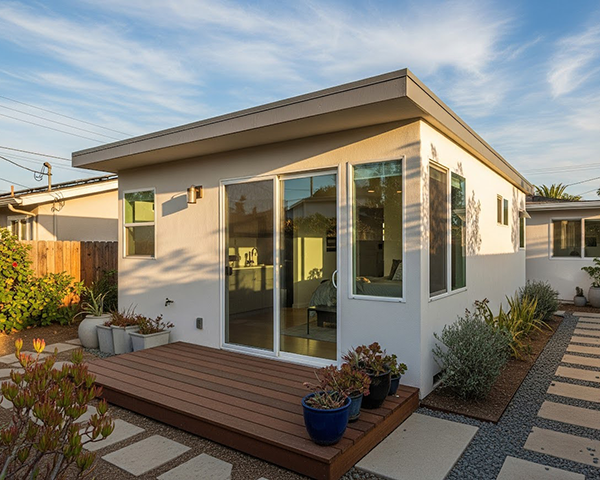
You’ve probably noticed the rise of Accessory Dwelling Units (ADUs) in North County San Diego. According to the California Department of Housing and Community Development (HCD), 3,991 ADUs were permitted in the San Diego region in 2024. That’s 27% of all housing permitted in the San Diego region of that year. Following a 2019 state law that mandated cities create plans to encourage the development of ADUs for moderate- and lower-income residents, they are popping up behind remodeled craftsman homes in Oceanside, tucked beside suburban properties in Vista, and being added to investment properties in Escondido. With the housing shortage, the push for more rental options, and rising home prices, many homeowners are wondering if turning their ADU into a rental is actually worth it.
The Short answer: For most people, yes. That is if done with clear expectations and a plan.
ADU Rentals in San Diego: Smart Move or Money Pit?
What makes ADUs so attractive in San Diego?
Here are a few things working in your favor. First, there is a constant demand for rental housing. San Diego’s rental market is always busy, fueled by a varied demographic. This includes:
- Young professionals who find downtown too expensive.
- Single parents seeking cost-effective housing.
- Retirees aiming to move into smaller homes.
Even during seasonal dips, the demand stays steady, especially in North County, where commute times and lifestyle options make small rentals appealing.
Second, ADUs tend to be lower maintenance than full homes. You’re not dealing with sprawling yards or massive appliances. This alone makes them perfect for first-time landlords.
Lastly, California has made it easier, legally and financially, to build and rent them. If your ADU is already completed, you’re in an even better position because half the battle is already won.
What can you realistically earn?
While rental income varies depending on location and finishes, most ADUs rent between $1,600 and $2,500 per month. Closer to the coast, furnished options and/or units with private yards can go north of $3,000.
For many homeowners, this income covers a significant portion of their mortgage or becomes a strong supplemental revenue stream. Some even use ADU rental income to accelerate paying off their home or fund future investments.
But remember, what you earn depends on:
- Square footage
- Privacy and parking
- Whether utilities are included
- Furnished or unfurnished
- Proximity to schools, transit, and shops
If you list the ADU properly and maintain it well, you can expect reliable occupancy because renters love a clean, modern, low-maintenance space.
Costs you need to keep in mind
Here is where first-time landlords often get surprised. Renting out an ADU is profitable, but not free from responsibilities or expenses. You should budget for:
- Repairs and maintenance. Even small issues add up. Expect at least 5 to 10 percent of your rental income to go toward maintenance over time.
- Wear and tear. Tenants use the home differently than you would. Plan for paint touch ups, appliance upkeep, or minor fixes between tenants.
- Property management if you don’t want to handle it yourself. This typically runs around 8 to 10 percent of your monthly rent.
- Utilities, if you don’t have separate meters. Some owners prefer bundling a flat fee.
- Insurance coverage adjustments. You will need landlord-specific protection.
The good news is the income usually outweighs these expenses by a healthy margin.
Should you manage it yourself or hire someone?
Many first-time hosts think self-managing will be easy. And for some people, it is. But if you are busy, or you prefer not to deal with late-night calls about a leaking faucet or questions about where the trash bins go, hiring a property manager is worth every dollar.
A good property manager finds tenants, screens them, collects payments, handles issues, schedules repairs, and keeps everything legally compliant. For a first-time landlord, this can be the difference between a smooth experience and a stressful one.
If you’re unsure, start by asking yourself:
- Do I have time to manage this?
- Am I comfortable enforcing rules?
- Do I know how to screen tenants properly?
If the answer to any of these is no, a property manager makes your ADU feel like a true passive-income investment.
What about short-term rentals?
Short-term rentals sound exciting, especially in a tourist destination like San Diego. But there are strict regulations, required permits, and caps on STR licenses in many neighborhoods. If your property doesn’t qualify, long-term renting will be your reliable, stress-free option. Even if you do qualify, managing short-term guests is a job in itself. Most new landlords prefer starting with long-term rentals.
So is it really worth it?
For most homeowners in North County, renting out an ADU is one of the smartest financial moves they can make. You get steady income. Your property value often increases. And you build long-term wealth with relatively low risk.
If you approach it thoughtfully, set clear expectations, price it correctly, and keep the unit in good condition, turning your ADU into a rental can become one of the most worthwhile decisions you ever make.
And if you ever need help evaluating rental potential or want guidance on how to get started, we’re always here to walk you through it in a way that feels simple and doable. Reach out anytime!




